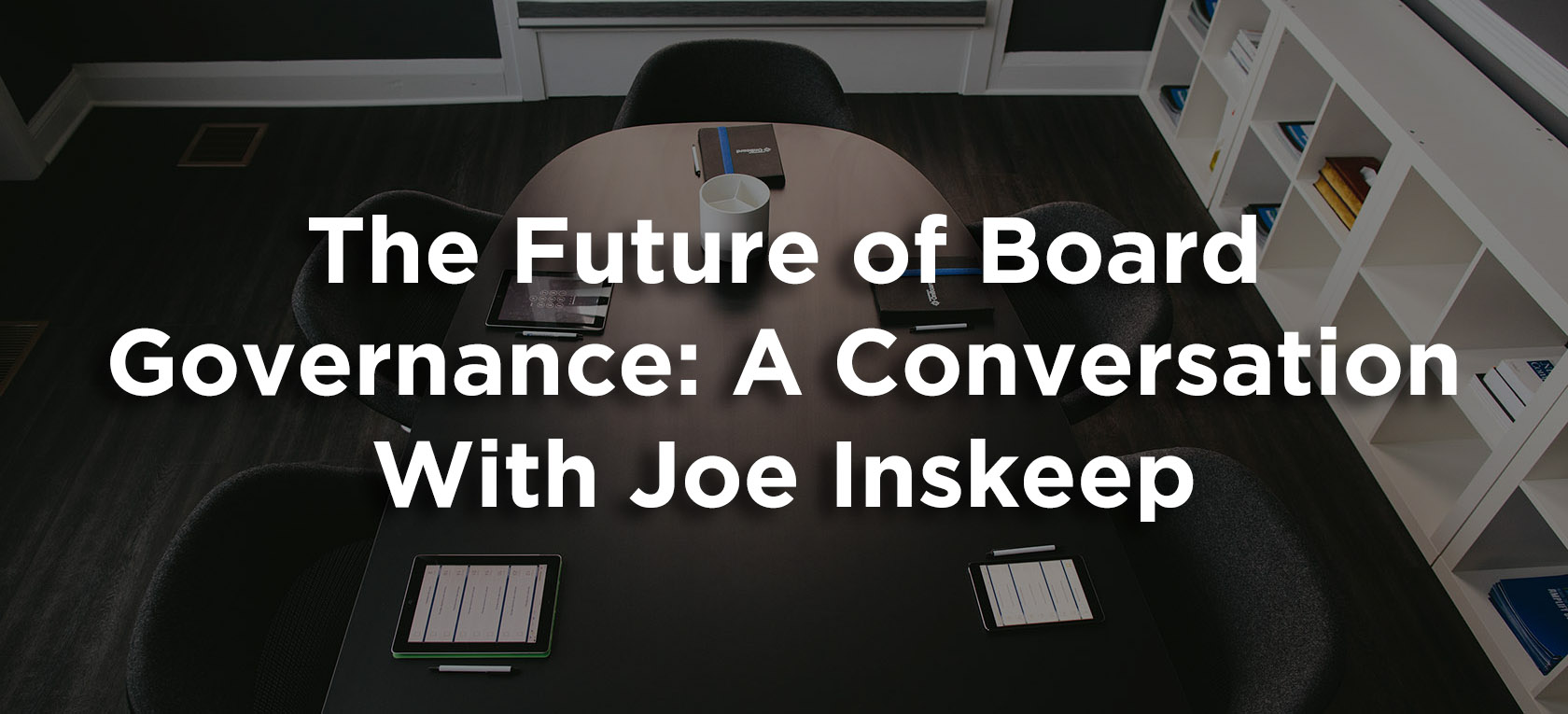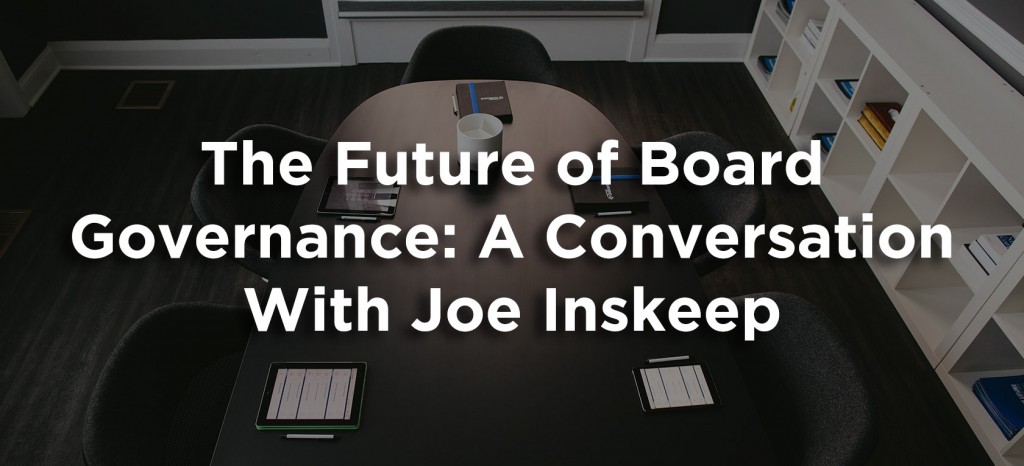 Joe Inskeep is chair of the Structure and Governance Committee of Shambhala, an international human development non-profit that operates over 200 centers across the globe. He has served this organization since 1983 in management, leadership training, faculty, and governance roles. His knowledge of board governance is rich, and his thoughts about board the future of board governance is deeply fascinating. So when I got a chance to sit down with Joe recently, I asked him to take the long view — what is board governance, how has it changed, and where it’s going.
Joe Inskeep is chair of the Structure and Governance Committee of Shambhala, an international human development non-profit that operates over 200 centers across the globe. He has served this organization since 1983 in management, leadership training, faculty, and governance roles. His knowledge of board governance is rich, and his thoughts about board the future of board governance is deeply fascinating. So when I got a chance to sit down with Joe recently, I asked him to take the long view — what is board governance, how has it changed, and where it’s going.
How would you describe corporate governance, and what sets a company with good corporate governance apart from one that is poorly managed?
The purpose of the governing board, when reduced to its essence, is to “ensure, usually on behalf of others, that an organization achieves what it should achieve while avoiding those behaviors and situations that should be avoided”. That quote is from Boards That Make a Difference, by John Carver. That’s it in a nutshell, and the quote is revealing.
It says that the board’s first job is to provide assurance. Assurance to whom? At its simplest, and in all cases, it’s assurance to the larger society. But secondly, it is assurance to the organizational owners. Boards don’t represent themselves. They are agents representing the interests of some group of “owners”. Owners are easy to identify in corporations; they are the shareholders. Owners are sometimes less obvious in nonprofits and public settings, but an equivalent “ownership” principle does exist. The Jasper City Council has citizens, and the Florida Montpellier Florist Association has members. Governing boards need to identify ownership and owner perspectives with some specificity in order to represent them well.
The quote also tells us that governing boards need to define organizational ends (results to be produced) and constrain organizational means (methods used to produce them). This is a way of saying that boards are accountable for both guidance and control. When you go a little deeper, this is what is behind a lot of board policy.
In this sense, corporate governance is not fundamentally different from governance in nonprofit and public settings. In all cases, well-governed organizations are responsive to the needs of their owners, and thereby ensure the right results and avoidance of unacceptable conditions.
We can add that the board of a well-governed company knows that the roles of governance and management are distinct and has learned to govern with appropriate boundaries and outputs for each.
How has corporate governance changed over time and how has it impacted organizations?
Actually, even though boards are perched at the top of the organizational house, they’ve been slow to innovate. Remarkably so. This is probably because they are depicted above and outside the operational chart. The industry has noticed this paralysis for a while. Management innovation has been center stage for decades while boards sit quietly backstage. The subject of board governance hasn’t been discussed much. But boards are held accountable for organizational performance so they’re often dragged into view when their organizations fail.
Most of us have seen spectacular failures recently. They’ve forced governance changes, especially in the publically traded markets. It was the collapse of Enron and Arthur Anderson that got it started. The result was the Sarbanne-Oxley legislation that mandated increased board and executive accountability, financial compliance, external audit, and penalties for fraud and mismanagement, and the like.
Still, the vast majority of governing boards are not compelled by this legislation and continue to struggle with their role. The question comes back to how might boards have their arms responsibly around their organizations without having their fingers fudged up into all the details.
What are some mistakes boards make in guiding their organization?
If we set aside the universe of dysfunctional and ineffective behavior that can happen in any group, the single biggest mistake boards make is not having a cohesive theory of governance. Why are we here? What are we meant to do? Without a clear, proactive governance agenda boards often find themselves continually reacting to executive agendas with responsible questions followed by some version of approval or micromanagement. This sort of thing is not governance, it is some form of management.
Governing boards have real work to do. It is inspired work that helps ensure an effective present but, even more importantly, leads an organization into its preferred future. To do this boards have to really take on the work, and that involves more than two hours per month, or four hours per quarter. The real mistake is misunderstanding the nature and commitments of board leadership and the potential impact boards can have.
How has technology impacted board governance?
In my experience, the most obvious impacts involve accessibility to board work. Nothing replaces face-to-face contact, but online conferencing offers low cost access to virtual rooms to share information and do very high quality work. It’s becoming the norm. For boards that travel or add shorter sessions, or who want remote education, this technology makes a difference.
Another impact relates to communication. A board shares many documents — — bylaws, meeting minutes, reports and board policy. The policy manual evolves but need to be kept current and accurate. For boards that monitor policy and review performance reports, having access to web based platforms where all these can be collected, displayed and commented on is invaluable. For example, board members can review performance reports and record their views related to compliance between sessions, freeing up meeting time to focus on future-focused topics.
What do you see as see the future of board governance and will technology continue to change the way it is conceptualized and practiced?
I think the most exciting governance work may come in the area of strategic foresight. Of all the potential organizational futures, which is the preferred ? In order to describe the preferred future, boards need to know a lot about the perspectives of its ownership and the organizational context, and how each of these is evolving. Technology will allow boards to access more of this information.
About The Author

- At OnBoard, we believe board meetings should be informed, effective, and uncomplicated. That’s why we give boards and leadership teams an elegant solution that simplifies governance. With customers in higher education, nonprofit, health care systems, government, and corporate enterprise business, OnBoard is the leading board management provider.
Latest entries
 Board Management SoftwareJuly 26, 20225 Critical Board Engagement Survey Questions
Board Management SoftwareJuly 26, 20225 Critical Board Engagement Survey Questions Board Management SoftwareJuly 19, 2022What is an Advisory Council? (Overview, Roles, and Responsibilities)
Board Management SoftwareJuly 19, 2022What is an Advisory Council? (Overview, Roles, and Responsibilities) Board Management SoftwareJuly 15, 2022Balance Sheet vs. Income Statement: What’s the Difference?
Board Management SoftwareJuly 15, 2022Balance Sheet vs. Income Statement: What’s the Difference? Board Management SoftwareJuly 12, 2022Sweat Equity: Mark Haas of the Dallas Cup Board Gives a Nonprofit Play-by-Play for Success
Board Management SoftwareJuly 12, 2022Sweat Equity: Mark Haas of the Dallas Cup Board Gives a Nonprofit Play-by-Play for Success

